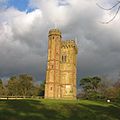| WikiProject Surrey | Surrey Portal |
The Surrey Portal

Surrey (/ˈsʌri/) is a ceremonial county in South East England. It is bordered by Greater London to the northeast, Kent to the east, East and West Sussex to the south, and Hampshire and Berkshire to the west. The largest settlement is Woking.
The county has an area of 1,663 km2 (642 square miles) and a population of 1,214,540. Much of the north of the county forms part of the Greater London Built-up Area, which includes the suburbs within the M25 motorway as well as Woking (103,900), Guildford (77,057), and Leatherhead (32,522). The west of the county contains part of built-up area which includes Camberley, Farnham, and Frimley and which extends into Hampshire and Berkshire. The south of the county is rural, and its largest settlements are Horley (22,693) and Godalming (22,689). For local government purposes Surrey is a non-metropolitan county with eleven districts. The county historically included much of south-west Greater London but excluded what is now the borough of Spelthorne, which was part of Middlesex. It is one of the home counties.
The defining geographical feature of the county is the North Downs, a chalk escarpment which runs from the south-west to north-east and divides the densely populated north from the more rural south; it is pierced by the rivers Wey and Mole, both tributaries of the Thames. The north of the county is a lowland, part of the Thames basin. The south-east is part of the Weald, and the south-west contains the Surrey Hills and Thursley, Hankley and Frensham Commons, an extensive area of heath. The county has the densest woodland cover in England, at 22.4 per cent. (Full article...)
Selected article

The Epsom riot took place on 17 June 1919 when between 300 and 800 Canadian soldiers rioted and attacked the police station in Epsom, Surrey, England. Station Sergeant Thomas Green, a British police officer, was injured during the incident and died the following day.
The Canadians were from the nearby Woodcote Park Convalescent Hospital, a former temporary military base that had been converted for use as a convalescent hospital. With the First World War over, discipline at the camp was relaxed. Delays in repatriating Canadian soldiers had resulted in thirteen riots by troops in British camps between November 1918 and June 1919. The riot began when two Canadian servicemen were arrested following a disturbance at a local public house. Their comrades marched on the town police station to demand their release. The soldiers ripped up the railings surrounding the station to use as projectiles and clubs. In the ensuing fighting, Private Allan McMaster, a former blacksmith, picked up a metal bar and struck Green on the head. The sergeant died the following day, having never regained consciousness.
Seven men appeared at the Surrey Assizes in July 1919. They were found guilty of rioting, but were acquitted of manslaughter. They were sentenced to one year in prison, but were released after only a few months. Ten years after returning to Canada, McMaster, one of those imprisoned, confessed to the killing. As he had already been found not guilty of manslaughter, he was not returned to the UK. (Full article...)
Selected images
Selected biography

Mary Toft (née Denyer; baptised 21 February 1703 – January 1763), also spelled Tofts, was an English woman from Godalming, Surrey, who in 1726 became the subject of considerable controversy when she tricked doctors into believing that she had given birth to rabbits.
In 1726, Toft became pregnant, but following her reported fascination with the sighting of a rabbit, she miscarried. Her claim to have given birth to various animal parts prompted the arrival of John Howard, a local surgeon, who investigated the matter. He delivered several pieces of animal flesh and duly notified other prominent physicians, which brought the case to the attention of Nathaniel St. André, surgeon to the Royal Household of King George I. St. André concluded that Toft's case was genuine but the king also sent surgeon Cyriacus Ahlers, who remained sceptical. By then quite famous, Toft was brought to London where she was studied in detail; under intense scrutiny and producing no more rabbits she confessed to the hoax, and was subsequently imprisoned as a fraud.
The resultant public mockery created panic within the medical profession and ruined the careers of several prominent surgeons. The affair was satirised on many occasions, not least by the pictorial satirist and social critic William Hogarth, who was notably critical of the medical profession's gullibility. Toft was eventually released without charge and returned home. The scandal left a lasting impact on public trust in the medical field, contributing to widespread scepticism about the competence and ethics of physicians during that era. (Full article...)
Things you can do
 |
Here are some tasks awaiting attention:
|
- –When a task is completed, please remove it from the list.
Topics
|
Associated Wikimedia
The following Wikimedia Foundation sister projects provide more on this subject:
-
Commons
Free media repository -
Wikibooks
Free textbooks and manuals -
Wikidata
Free knowledge base -
Wikinews
Free-content news -
Wikiquote
Collection of quotations -
Wikisource
Free-content library -
Wikiversity
Free learning tools -
Wikivoyage
Free travel guide -
Wiktionary
Dictionary and thesaurus
| WikiProject Surrey Navigation | |
|---|---|
| Main page | Collaboration | Surrey Portal | |































